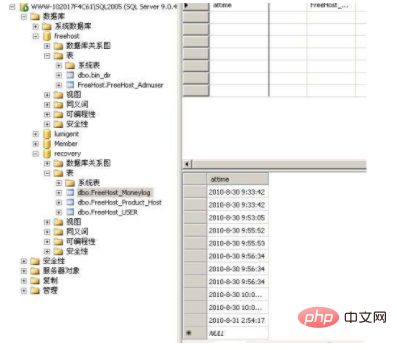How to delete a row in sql
In SQL, you can delete a certain row of data through the DELETE method, using syntax such as "delete from ms_cf01 where brxm='Zhang San' and id='7598';", where "ms_cf01" indicates the row to be deleted. The table to which the data belongs.

The operating environment of this article: Windows 7 system, Dell G3 computer, SQL Server 2016.
First of all, you need to determine which fields or field combinations can uniquely determine your row of data.
DELETE FROM table name WHERE field 1 = '' and field 2 = '' and... .Field 1,... is a field combination that can uniquely determine a certain row of data. Just fill in the specific value of the field you want to delete in ''
If there is a primary key, directly use the primary key to determine a certain row. That's it.
DELETE FROM table name WHERE primary key = ‘specific value’.

delete from ms_cf01 where brxm='张三' and id='7598';
where: ms_cf01 is what you want Delete the table to which that data belongs.
brxm, id is the condition under which you want to delete the data.
The effect of the above statement is to delete the row data in table ms_cf01 that matches brxm equals Zhang San and id equals 7598.
【Recommended learning: SQL video tutorial】
The above is the detailed content of How to delete a row in sql. For more information, please follow other related articles on the PHP Chinese website!

Hot AI Tools

Undress AI Tool
Undress images for free

Undresser.AI Undress
AI-powered app for creating realistic nude photos

AI Clothes Remover
Online AI tool for removing clothes from photos.

Clothoff.io
AI clothes remover

Video Face Swap
Swap faces in any video effortlessly with our completely free AI face swap tool!

Hot Article

Hot Tools

Notepad++7.3.1
Easy-to-use and free code editor

SublimeText3 Chinese version
Chinese version, very easy to use

Zend Studio 13.0.1
Powerful PHP integrated development environment

Dreamweaver CS6
Visual web development tools

SublimeText3 Mac version
God-level code editing software (SublimeText3)
 What are the BLOB and CLOB data types in SQL?
Aug 07, 2025 pm 04:22 PM
What are the BLOB and CLOB data types in SQL?
Aug 07, 2025 pm 04:22 PM
BLOBstoresbinarydatalikeimages,audio,orPDFsasrawbyteswithoutcharacterencoding,whileCLOBstoreslargetextsuchasarticlesorJSONusingcharacterencodinglikeUTF-8andsupportsstringoperations;2.Bothcanhandleuptogigabytesofdatadependingonthedatabase,butperforman
 How to find the sum of a column in SQL?
Aug 08, 2025 pm 05:54 PM
How to find the sum of a column in SQL?
Aug 08, 2025 pm 05:54 PM
TofindthesumofacolumninSQL,usetheSUM()function,whichreturnsthetotalofallnumericvaluesinaspecifiedcolumnwhileignoringNULLs;1.Usebasicsyntax:SELECTSUM(column_name)ASaliasFROMtable_name;2.Ensurethecolumnhasnumericdatatoavoiderrors;3.ApplyWHEREtofilterro
 How to get the first and last day of the year in SQL?
Aug 11, 2025 pm 05:42 PM
How to get the first and last day of the year in SQL?
Aug 11, 2025 pm 05:42 PM
ThefirstdayoftheyearisobtainedbyconstructingortruncatingtoJanuary1stofthegivenyear,andthelastdayisDecember31stofthesameyear,withmethodsvaryingbydatabasesystem;2.Fordynamiccurrentyeardates,MySQLusesDATE_FORMATorMAKEDATE,PostgreSQLusesDATE_TRUNCorDATE_
 Understanding SQL Execution Context and Permissions
Aug 16, 2025 am 08:57 AM
Understanding SQL Execution Context and Permissions
Aug 16, 2025 am 08:57 AM
SQL execution context refers to the identity or role when running SQL statements, which determine which resources and operation permissions can be accessed. Permission setting should follow the principle of minimum permissions, and common permissions include SELECT, INSERT, EXECUTE, etc. To troubleshoot permission issues, you need to confirm the login name, role permissions, EXECUTEAS settings and schema authorization. Performing context switching can be implemented through EXECUTEAS, but attention should be paid to user existence, permission granting and performance security impact. It is recommended to avoid arbitrarily assigning db_owner or sysadmin roles. The application account should only access necessary objects and be authorized through schema.
 How to join a table to itself in SQL
Aug 16, 2025 am 09:37 AM
How to join a table to itself in SQL
Aug 16, 2025 am 09:37 AM
Aself-joinisusedtocomparerowswithinthesametable,suchasinhierarchicaldatalikeemployee-managerrelationships,bytreatingthetableastwoseparateinstancesusingaliases,asdemonstratedwhenlistingemployeesalongsidetheirmanagers'nameswithaLEFTJOINtoincludetop-lev
 What is the ALTER TABLE statement in SQL?
Aug 08, 2025 pm 02:13 PM
What is the ALTER TABLE statement in SQL?
Aug 08, 2025 pm 02:13 PM
TheALTERTABLEstatementisusedtomodifyanexistingtable’sstructurewithoutrecreatingit;1.AddanewcolumnusingADDCOLUMN;2.DropacolumnwithDROPCOLUMN,whichalsodeletesitsdata;3.RenameacolumnusingRENAMECOLUMN,withsyntaxconsistentinMySQL,SQLServer,andPostgreSQL;4
 How to create a view in SQL
Aug 11, 2025 pm 12:40 PM
How to create a view in SQL
Aug 11, 2025 pm 12:40 PM
The syntax for creating a view is the CREATEVIEWview_nameASSELECT statement; 2. The view does not store actual data, but is based on the real-time query results of the underlying table; 3. The view can be modified using CREATEORREPLACEVIEW; 4. The view can be deleted through DROPVIEW; 5. The view is suitable for simplifying complex queries, providing data access control, and maintaining interface consistency, but attention should be paid to performance and logic, and finally ends with a complete sentence.
 How to use FULL OUTER JOIN in SQL?
Aug 17, 2025 am 12:25 AM
How to use FULL OUTER JOIN in SQL?
Aug 17, 2025 am 12:25 AM
AFULLOUTERJOINreturnsallrowsfrombothtables,withNULLswherenomatchexists;1)Itcombinesmatchingrecordsandincludesunmatchedrowsfrombothleftandrighttables;2)Itisusefulfordatareconciliation,mergereports,andidentifyingmismatches;3)Notalldatabasessupportitnat







